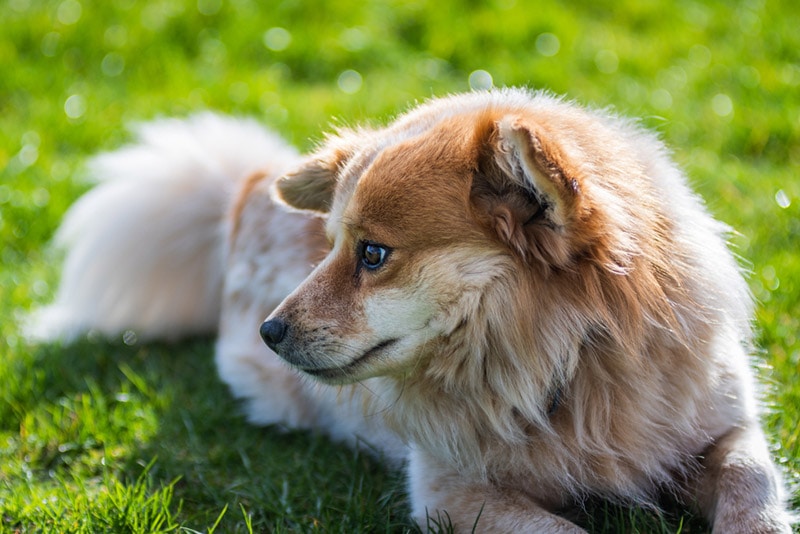Are Dogs Carnivores or Omnivores? Canine Nutritional Needs Explained
Updated on
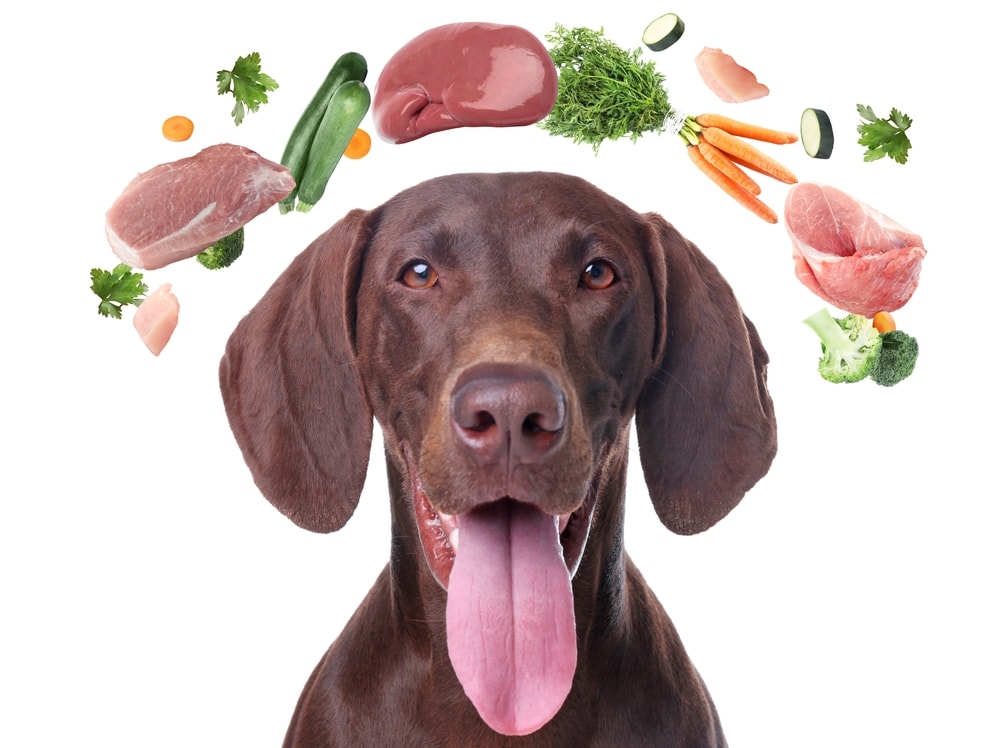
Many people believe that dogs are complete carnivores as they definitely seem to get more excited for a piece of steak or chicken than they do for broccoli or green beans.
The truth is that dogs are generally thought to be facultative carnivores depending on what food is available to them, but there’s ongoing research that’s continuously examining this assumption.
This is a surprisingly complex debate that likely isn’t going to be resolved anytime soon, but it’s still worth diving into to understand both sides of the argument.
Are Dogs Omnivores?
The conventional wisdom holds that dogs are omnivores, which is why commercial dog foods are loaded with fruits, vegetables, and grains, in addition to meat.
There are many important nutrients in fruits and veggies that dogs need, but that’s not usually why people argue that they’re omnivores.
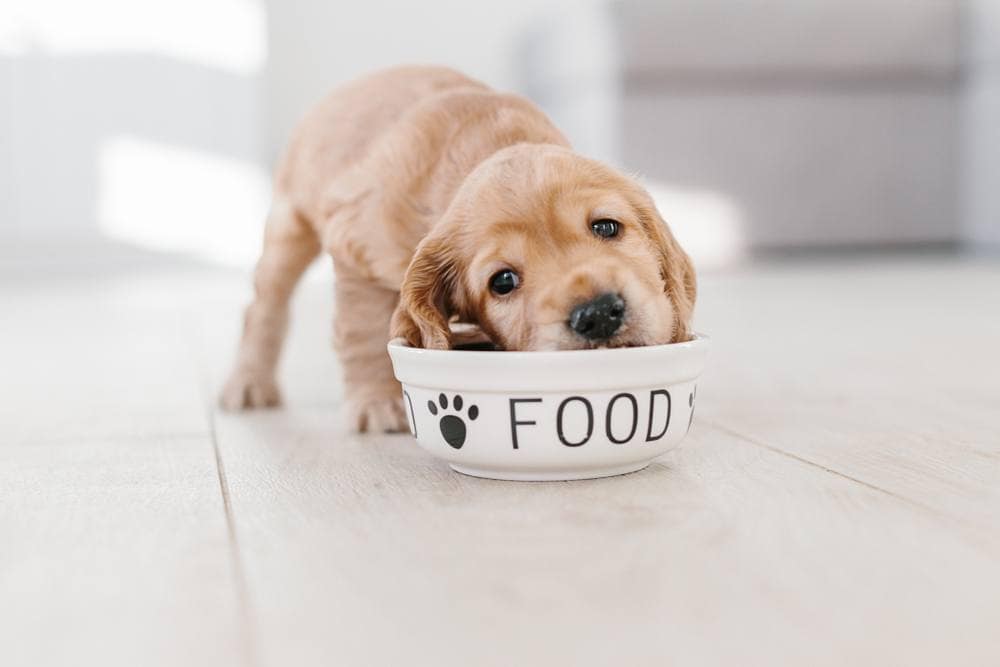
Dog Evolution: Are Wolves Omnivores?
Many people claim that since dogs are descended from wolves and wolves have been observed eating grass or chomping on undigested plant matter while eating the stomachs of their victims, dogs must eat plants as well.
There are a few issues with this argument, however. Wolves are very adaptable carnivores and their diet is based on meat protein. Research shows that plant materials, mainly grass, can be present in as many as 74% of wolf fecal samples during summer months, based on reduced availability of their usual prey.1
It’s also safe to assume wolves only consume plant matter as a survival mechanism, not a preference. If they could grow, reproduce, and repair bodily tissues with plant matter alone, it would make no evolutionary sense for them to risk their lives hunting animals, as many of the animals they normally hunt have the ability to inflict injuries on them.
Perhaps the biggest argument is that we no longer believe domesticated dogs to be descended from wolves in the way it was previously assumed—or at least, they’re not descended from modern wolves, anyway. Instead, it’s thought that both dogs and modern wolves could share a common ancestor: a different, long-extinct species of wolf. Further research is required regarding this matter, as the DNA samples of these animals are scant.
Since there is no available info on what these extinct wolves might have been eating, and the diet of modern wolves now might seem irrelevant to the discussion, based on this, we cannot draw too many conclusions about our dogs, as they have evolved and adapted to living alongside us ever since.
Even if the diet of modern wolves was relevant, though, it wouldn’t help the omnivore argument, as wolf experts now believe the animals to be completely carnivorous.
Dog Intestinal Size
For carnivores, meat is easier to digest than plants are based on their source and way they have been processed. Plant food sources contain cellulose in varying amounts, and dogs lack the enzyme called cellulase that is required for digestion of fiber. Further studies are required to establish the amount and diversity of intestinal bacteria present in omnivores and carnivores that may help them in digestion of plant food sources, while true herbivores have abundant bacterial flora that helps them utilize fiber.
The intestinal length of obligate carnivores is usually much shorter than that of herbivores or omnivores. Cats, for example, have very short digestive tracts in comparison to their body size.
Dogs have medium-sized digestive tracts – longer than cats and other obligate carnivores, but shorter than many other herbivores and omnivores.
Due to extreme variability in dog breeds and sizes, varying from one to even 200 pounds, recent research has shown that there may be a difference between the breeds in function and level of digestion of certain food sources in particular parts of the digestive tract. Large breeds may have a more sensitive digestion that requires highly digestible sources of proteins and starches with addition of fiber.
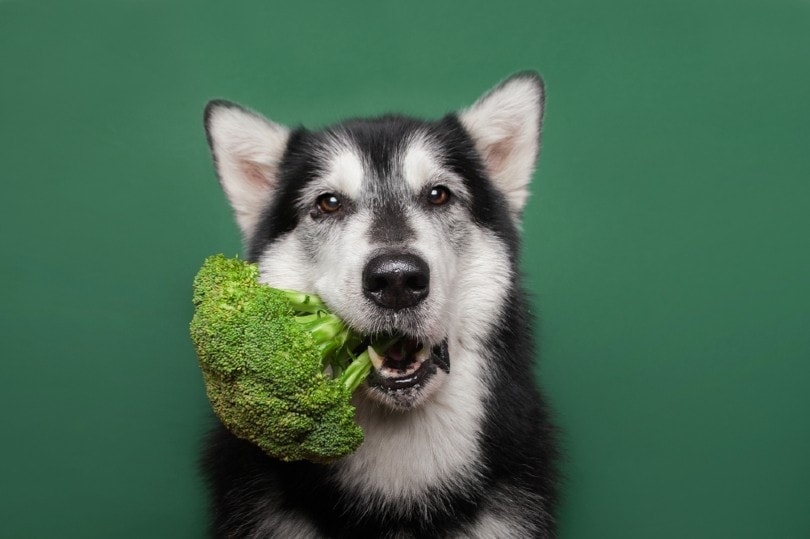
Dog Evolutionary Adaptation
This is probably the strongest argument in favor of dogs being omnivores. There are three genes that have evolved only in dogs and are specifically designed for starch and glucose digestion, unlike wolves. Why would they have those if they weren’t supposed to eat starch and glucose?
It’s important to note that wolves and other undomesticated canine relatives still may have these genes, but only very few gene copies in comparison to domestic dogs, causing reduced and much less efficacious activity of the enzymes responsible for digesting starch. It’s thought that dogs developed them from scavenging in and around human settlements thousands of years ago.
However, while this adaptation proves that dogs can eat plants and grains, it doesn’t exactly prove that they should rely purely on them as a source of nutrition. It just means their bodies are capable of processing such foods. Generally speaking, developing a handful of genes may not be considered sufficient to change a species’ entire digestive evolution.
Being Omnivorous Is Better for Business
This is less of an actual evidence-based argument for dogs being omnivores and more of a possible explanation for why so many people believe that dogs need plants and grains in their diets.
Simply put, meat is expensive due to the long and intensive production process—much more expensive than, say, corn, wheat, oats, or broccoli. Dog food manufacturers want to keep their costs low as much as possible, so the more meat that they can replace with food sources like starches, the more they’ll save in the long run and the less impact it will have on our planet.
Using animal meat in dog food is generally terrible for the environment. In fact, owning a medium-sized dog could be comparable to owning a large SUV in terms of carbon footprint. The best way to minimize this is to efficiently use every appropriate part of the animals we raise for human food, including organs, as these “by-products,” can be very good-quality sources of nutrients that dogs enjoy.
Dogs do require animal proteins in their diet, though, and an exclusively vegetarian diet might be harmful for your pooch. But your vet and a canine nutritionist can advise you on the best ways to incorporate dog safe plant based food sources in your dog’s diet alongside meats, in order to keep them healthy, while reducing the impact of the meat industry on our planet.

Are Dogs Carnivores?
While no one disputes the fact that dogs are largely meat eaters or the fact that they seem to prefer meat to other food sources, historically, it was suggested that they might be obligate carnivores, just like cats.
Some of the previous arguments supporting this claim have been replaced by new research that has shown that while a dog’s diet can be based on meat, evolution has allowed them to develop traits ensuring good usage of carbohydrates. We also know they can eat plant food sources as well, although digestion of these is limited by the amount of cellulose.
However, some veterinary professionals are arguing whether dogs remain carnivores, as they have adapted to living with humans, allowing them to eat a grain diet alongside meat. Let’s discuss some of those arguments and see if they can be applied today.
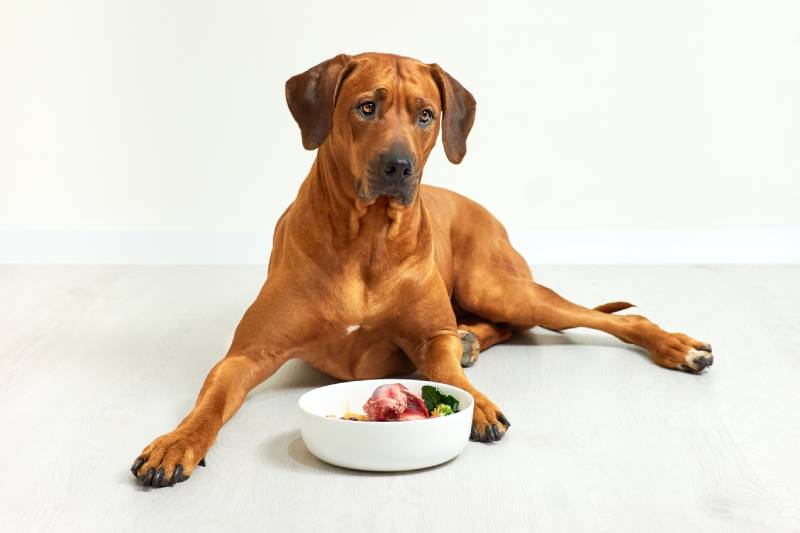
Dog Teeth
One of the easiest ways to tell a carnivore from a herbivore or omnivore is to look at the animal’s teeth. Herbivores have rows of flat wide molars, perfect for grinding up grains, grasses, and other plants.
Carnivores, on the other hand, tend to have sharp incisors and canine teeth. These are designed for catching other animals and then ripping the flesh off before swallowing it, while using their flattened premolars and molars with uneven but often sharp edges, to shred and crunch on food.
As you might expect, omnivores—like humans—have a mixture of both.
So, what kind of teeth do dogs have? They have rows of sharp teeth used for catching their prey, and uneven premolars and molars perfect for dicing and tearing meat into manageable chunks. Carnassial teeth are the cheek teeth found in carnivorous animals, the upper fourth premolar and the lower first molar. They are large and pointy which allows them to shear flesh and bone. Dog’s teeth do seem more adjusted to a carnivorous diet.
There are also differences in shape and relative size of the animal’s jaw in comparison to the head, and the speed of closing the mouth. Carnivores have intermediate to short jaws that close quickly, and herbivores have short jaws. Another difference is present during chewing at the connection between the lower jaw and the skull, the so-called temporomandibular joint (TMJ).
Masticatory muscles are responsible for this movement that allows chewing, but the dominant muscles differ between carnivores, herbivores, and omnivores. In dogs, similarly to cats that are specialized carnivores, there is a hinge-like TMJ with dominance of the temporalis muscle, while in omnivores and herbivores, masseter and medial pterygoid muscle are responsible for moving the TMJ forth and back. All of this allows carnivores to open and close their jaws quickly when grasping at a prey animal and allows them to tear and chew animal tissues.
That doesn’t mean they can’t eat plants, which is something that any dog owner who has observed their pet eating grass can attest. However, if you’ve seen the grass come out the other end mostly intact, you know that the digestive process wasn’t exactly smooth.
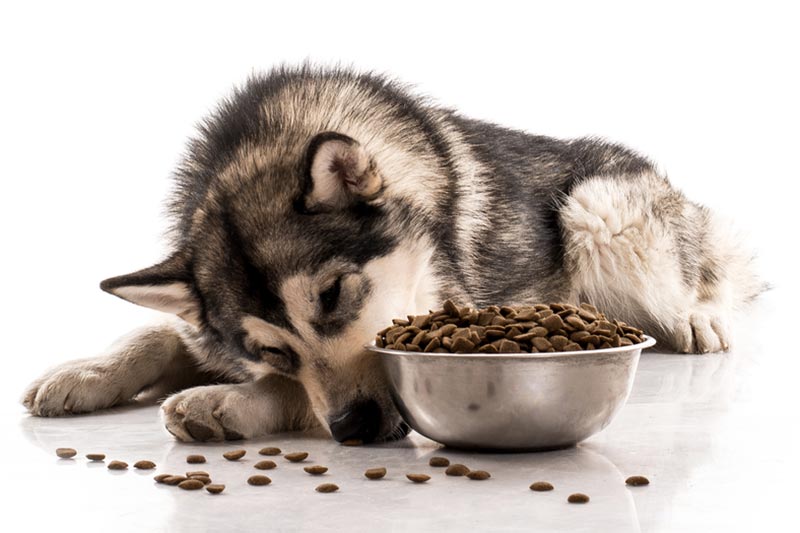
The Coefficient of Fermentation
This argument came about in relation to the one about intestinal length. Some scientists have argued that a more important factor to consider in determining an animal’s ideal diet is their coefficient of fermentation.
A big reason that herbivores can survive on plant-based diets is their ability to extract nutrition from those plants by fermenting them inside their guts thanks to the rich source of gut bacteria. These animals are said to have high coefficients of fermentation.
Dogs, on the other hand, have a low coefficient of fermentation that’s similar to cats, and cats are obligate carnivores.
Of course, this doesn’t prove that dogs can’t eat plants, but it suggests that they may not be able to wring all the nutrition out of non-meat sources, as diets excessive in fiber also reduce digestibility and may lead to increased volume and frequency of defecating.
Salivary Amylase
Some herbivores and most omnivores create a specialized enzyme in their saliva called amylase. Since starchy foods are so difficult to digest, the process starts in the mouth long before such foods reach the gut, and amylase in the saliva is responsible for breaking them down while they’re still being chewed.
However, dogs don’t produce amylase in their saliva. They do make it in their pancreas, which is why these foods can be digested inside their gut, but the process doesn’t start as early as it would in a true omnivore and could, therefore, be less efficient.
What’s more, based on recent research, carnivores and scavengers have a much higher concentration of stomach acid than most herbivores do. This suggests their stomachs are geared toward breaking down animal proteins as quickly as possible, but scientists now also believe the reason for this is to protect them against bacteria that can be present in the meat. However, humans as omnivores also have high acidity levels, likely adapted to modern feeding habits.
The acidity of a dog’s stomach is actually very variable, however when fasted the level of acidity, also called gastric pH, is similar to humans and other mammals, while cats seem to have a slightly more acidic stomach than dogs.
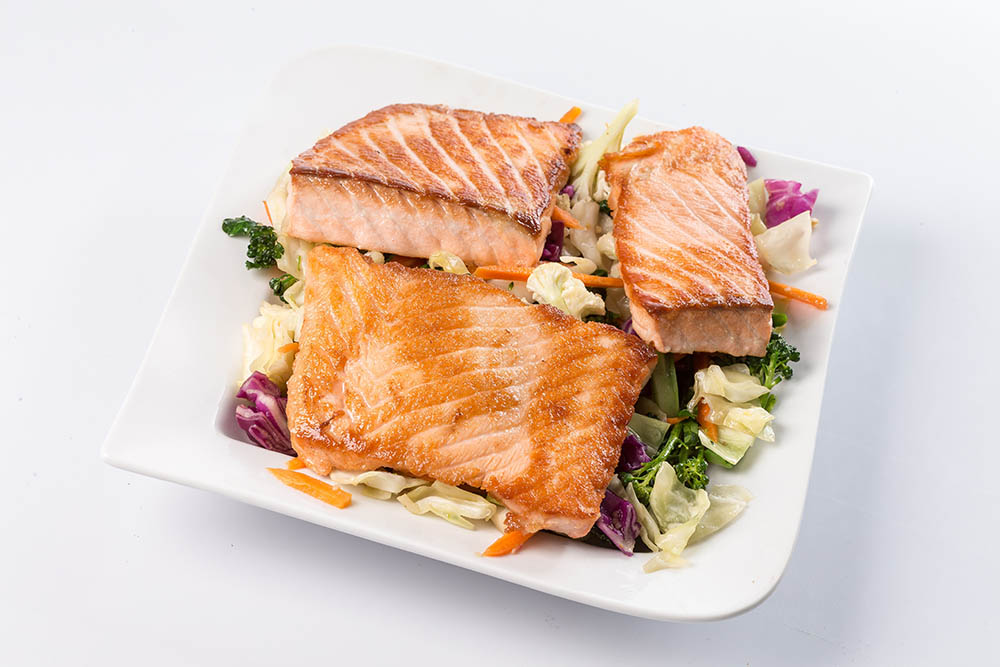
Dog Omega-3 Conversion
Omega-3 fatty acids are extremely important for any animal’s health. In humans and dogs alike, they do everything from supporting brain and eye development to warding off arthritis and kidney disease.
There are two ways to get omega-3s: Dogs can get them from plants, like flaxseed and chia, or from animal sources, like fish.
The plant-based omega-3s come in the form of alpha-linolenic acid, or ALA. However, for dogs to use it, they must first convert it to eicosapentaenoic acid or docosahexaenoic acid.
Most carnivores are unable to make this conversion at all. Dogs can do it, but they can only convert a limited amount of the ALA that they consume. As a result, they get much more nutrition from meat-based sources of omega-3s. However, there are some potential adverse effects of using omega-3 fatty acids in dogs with certain underlying medical conditions, and vets should be consulted before considering any supplements.
Dog Eating Routines
There are a variety of innate behaviors that dogs display that are closer to carnivores than omnivores or herbivores. One of these is the length of time that they can go without eating. Herbivores and omnivores typically eat frequently—several times a day, if possible. This is why animals like cows will graze constantly.
Carnivores, on the other hand, can go quite a long time between meals. After all, prey can be hard to come by, so the animal needs to be able to survive lean times.
Lean dogs also have quite a bit of flexibility inside their metabolic pathways. This is usually found in carnivores, such as wolves, as it helps them survive a “feast or famine” lifestyle.
Dogs will display other behavioral traits that are common in carnivores, like digging holes (for burying carcasses to hide them from scavengers, or looking for small prey) or learning to pounce while puppies (which is presumably for sneaking up on another animal, not a corn stalk).
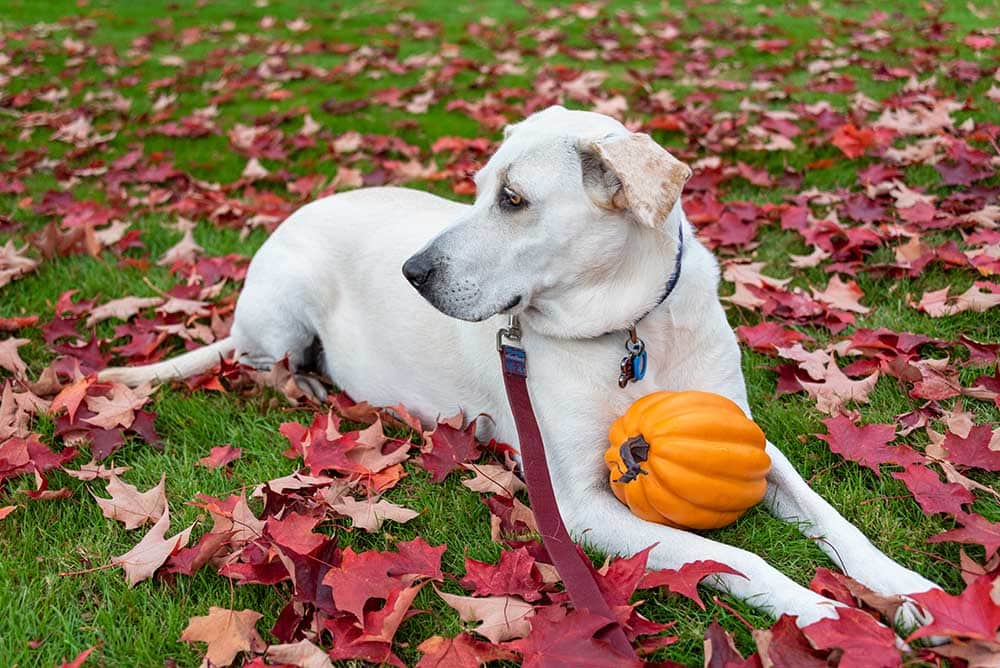
Are Dogs Carnivores or Omnivores?
This debate is far from over. However, the bulk of the evidence that we currently have available to us suggests that dogs are something called “facultative or opportunistic carnivores,” but there is no widely accepted consensus in the veterinary profession on this topic as of yet.
Unlike obligate carnivores, who only eat meat, facultative carnivores mostly eat meat but can and will eat other foods if they need to.
You may now be asking yourself, “So, what’s the difference between a facultative carnivore and an omnivore when it comes to our dogs?” That’s an excellent question—one that science doesn’t have a great answer for at the moment, although omnivores seem to have a much broader choice of food sources they are able to safely eat.
There’s not a clear line between the two, biologically speaking. It’s generally a judgment call based on which foods the animal seems to prefer to eat, as well as which ones are more nutritious for them.

What Does This Mean for My Dog’s Diet?
There is so much debate about what would constitute an ideal dog diet that it’s hard to give any definitive answers here. It is important to consult with your veterinarian and canine nutritionist on the best diet for your dog, as this will differ based on their age and life stage, size, level of activity, and general health.
A balanced and complete commercial dog diet sold in the United States that contains everything your pup needs is regulated and prescribed by The Association of American Feed Control Officials (AAFCO). Other countries will have their own governing body. Otherwise, in cooperation with your vet and a nutritionist, your dog can enjoy a balanced home-made diet that still contains all the required nutrients crucial for health.
That includes lean meat from a variety of sources, including organ meat, bone meal, and more. Dogs love all that stuff and their bodies thrive from eating it.
Your dog can still be extremely happy and healthy with some fruits and veggies in their diet, though. Indeed, many such foods are quite healthy for them, but you need to realize that your dog might not digest them as efficiently as they do meat.
If you’re feeding your dog a raw diet, it should consist mainly of meat rather than other food sources, such as bones, as these might cause gastroenteritis or even intestinal blockage in some dogs. However, you should talk to your vet first, just to make sure you’re not accidentally depriving your pup of something essential and your vet will advise you on pros and cons of feeding your dog raw food.
At the end of the day, dogs can thrive on a variety of diets as long as they are balanced and complete with a healthy ratio of animal protein and plant food sources, in accordance with AAFCO recommendations.
Conclusion
While we might not have a satisfactory answer to the “omnivore vs. carnivore” debate just yet, the good news is that most dogs aren’t terribly picky. They’ll happily eat whatever you put in front of them (or leave unattended on the kitchen counter).
That doesn’t mean that you shouldn’t worry about what you feed your pooch, of course. A healthy and balanced diet is imperative for your dog’s health. As long as you first consult with your veterinarian, do your research in a critical and evidence-based manner, and try to give your dog the most nutritious food possible following the AAFCO recommendations, you’re unlikely to go too wrong, regardless of which side you fall on in this argument.
- Related Read: Can Dogs Eat Raw Fish? Vet-Reviewed Facts & Safety Guide
Featured Image Credit: PixieMe, Shutterstock





